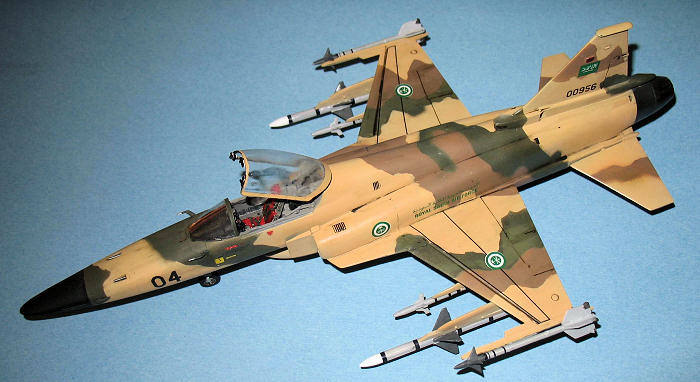
| KIT #: | 5445 |
| PRICE: | Long out of production |
| DECALS: | Two options |
| REVIEWER: | Dan Lee |
| NOTES: | FCM decals and KMC SIIIS seat used |

| HISTORY |
Few things are as terrifying for a fighter pilot as to turn as hard as his aircraft will sustain, the airframe at its structural limits under heavy buffet, and see behind him an opponent who cannot be pushed out of radius of turn. The Israeli captain watched in awe as the F-20C out-turned him, its nose beginning to pull inside his own turn radius. When he saw the underside of the Northrop’s fuselage, an icy hand clutched at his stomach—a terrifying certainty that the pilot behind him was able to track him in the gunsight.
With his neck twisted to scan behind
him, the twenty-seven-year-old Israeli’s head weighed nearly a hundred pounds.
His neck muscles strained to sustain the five-G load that his entry airspeed
allowed in a maximum-banked turn. Momentarily he thought of
 reversing the turn, but he knew
that would gain a few seconds respite at best. At worst, it would get him
killed sooner.
reversing the turn, but he knew
that would gain a few seconds respite at best. At worst, it would get him
killed sooner.
He thought of the other option. He could pull the yellow-and-black-striped handle between his knees and catapult himself out of the fight, into the Arabian Desert. He could live to see his family again.
He decided to fight.
In that instant, he saw the bright flashes from the F-20’s nose, and his life ended as 12 of the nearly 200 rounds in the burst raked the top of his aircraft, smashing the canopy, cockpit and seat.
(Ed) Lawrence leaned forward, his blue eyes animated. “You know Pirate, I felt invincible in the F-8. Nobody ever got a clear win over me after I got out of the training squadron. Not even you. But in the F-20…”
The redhead whistled softly. “In the Tigershark, I’m immortal. I tell you, no lie, G.I. As long as I play my game and keep my eyeballs moving, ain’t nobody can take me. And I’ve been up against the best.”
Jon (Pirate) Bennett chuckled inwardly, recognizing the same world-class ego in his friend which he had once possessed himself. “Well Jesus, Ed. I should hope that you’re that good. I mean, you only have seven thousand hours and one war up on the rest of these sports.”
The exec waved a deprecating hand, “No, no. I mean it. Look, it’s like I’m the world champion chess player. I don’t have to fear any other grand master. Whatever he shows me, it’s a move I’ve seen before or a strategy I’ve used myself.”
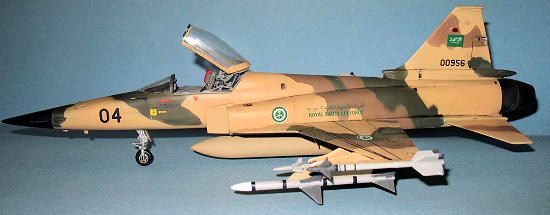 “Okay, I won’t dent your fighter
pilot’s ego. But for Pete’s sake, Devil, remember you’re pushing forty eight
years old. You can’t keep this up forever.”
“Okay, I won’t dent your fighter
pilot’s ego. But for Pete’s sake, Devil, remember you’re pushing forty eight
years old. You can’t keep this up forever.”
Of course, this is fiction as the F-20 never flew except as a prototype. Both excerpts came from Barrett Tillman’s 1990 novel, Warriors, which featured the F-20 Tigershark as one of the major “characters.”
As most of you know, the reality is that the only F-20s sold around the world are the various scale model kits made of it and the sole surviving Northrop F-20 is on display at the California Museum of Science. For a very brief history of the F-20, please see my preview of the F-20 kit.
I won this kit in an eBay auction because no one else wanted it. At the time, it was a consolation prize for losing a ProModeler 1/48 Helldiver kit I thought I won in the dying minutes of the auction when two guys came out of nowhere, piled on and I got outbid by 20 bucks. It turned that the joke was on the auction’s winner because I purchased the AM re-release of the same kit some six months later at a much cheaper price.
| THE KIT |
Please see my preview of the kit
| CONSTRUCTION |
I started with the cockpit. The details for this particular cockpit are very good when I compared it to the one photo I had of the Tigershark’s instrument panel. The interior was sprayed with a base coat of Gunze Sanyo Acrylic H317 Dark Gull Grey. I hand painted the details using various colors to get the instrument panel looking okay while using the photo as a guide. After I let the paint dry, I glued the cockpit into the fuselage and slapped the F-20 together.
The fuselage construction was pretty
straight forward. I also read over Steve Egger’s build review to see what I
could do to avoid any rough spots in construction. Unfortunately, I could not
find a way to improve the fit of the wicked seams around the engine compartment
aside from doing some serious filling and sanding. Yes, there a re
raised panel lines on this kit, but I am comfortable with my scribing skills to
redo any panels I sanded away so raised panel lines don’t scare me like they
used to.
re
raised panel lines on this kit, but I am comfortable with my scribing skills to
redo any panels I sanded away so raised panel lines don’t scare me like they
used to.
The plastic held up well with little or no warping with the exception of one piece—not bad for a 20 year old kit. That one piece, unfortunately, was the rather prominent port wing strake. Attempts to realign the part under hot water didn’t work so I set the model aside to think about a solution. After nearly suffering an aneurysm, I decided that the easiest solution was to chop up a piece of 20 thousand plastic card and glue it to the bottom of the port strake. The bottom of the strake was sanded flat with the wing using a coarse sanding stick while any gaps between the card and the plastic were filled with Mr Surfacer. The hard part was sanding down the warped top portion of the strake to be flat with the wing. It was not easy, but I managed to get a somewhat flat surface.
The gaps between the intakes and the rest of the fuselage were much easier to deal with as I simply filled them in with cut pieces of 10 thousand plastic card and I was done. I used a number 11 blade to redo the sanded off raised panel lines.
I liked the way Monogram used a modular approach for this kit as it is a much easier to build than the Classic Airframes F-5A kit (which I started but have yet to finish), but one needs to be careful to get a decent alignment out of pretty much everything.
The centerline fuel tank did not have the best fit. I had very large gaps along the centerline, but they were filled with CA glue and sanded it smooth to the best of my ability.
| COLORS & MARKINGS |
Painting
It was my intent to do this particular plane as a member of the fictional Tiger Force, but there was one slight problem—I didn’t know what the paint scheme was. The book’s interior painting was not much help as the artist drew up the F-20 in the prototype color of BMW metallic grey. I spent an evening flipping thru the novel to find marking information, but I couldn’t find any. Out of desperation, I emailed the author, Barrett Tillman, and got a quick reply. Mr Tillman explained to me that he saw the F-20s using the same paint scheme as Saudi Arabia’s F-5E Tigers. Armed with this information, I searched the internet for the “exact” camo pattern. I found an F-5E camo scheme on Cybermodeler along with the FS595 model numbers FS34079 (green), FS30400 (tan) and FS30140 (Dark Brown.)
From aerial photos of actual Saudi F-5Es, I discovered to my joy that the undersides of the F-5E were simply tan so I did not have to mask underneath.
The tan and brown FS numbers are not common colors, but I was fortunate to find them in the Poly Scale paint line (the Tan was actually FS10400.)
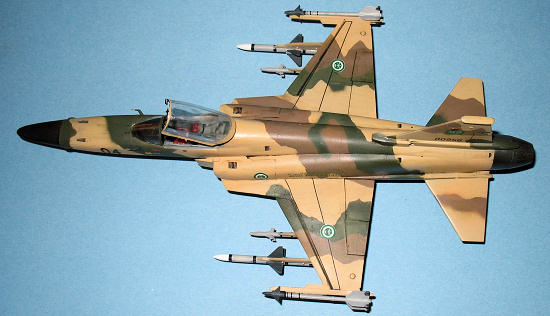 This particular camo scheme of
tan, brown and “spinach” was not an easy one to do. I started by pre shading
the plane with Tamiya flat black and painting the intakes silver. I waited a
couple of days for the paint to dry before using the Poly Scale paints (problems
with cracking if you don’t let the different manufacture’s paint dry first.)
This particular camo scheme of
tan, brown and “spinach” was not an easy one to do. I started by pre shading
the plane with Tamiya flat black and painting the intakes silver. I waited a
couple of days for the paint to dry before using the Poly Scale paints (problems
with cracking if you don’t let the different manufacture’s paint dry first.)
I sprayed several light coats of the US Special Tan for the first coat. It took a couple of hours to spray it on because I didn’t thin the Poly S enough and it clogged my Badger 150 airbrush. The bottle claims you only need to add 1 part thinner to 9 parts paint. That is not the case from my experience. It is closer to 50/50. The mix that works for me is 5 parts paint, 4 parts 70% alcohol and 1 part distilled water (the water slows down the drying process in both the model and the airbrush nozzle, but you MUST spray really thin coats or you will get runny paint.)
Once it was dry, I began the painful process of masking the brown. Having learned my lesson, I quickly sprayed the brown on without the clogging. Then a couple of weeks later, I sprayed the green. Like most other times I do hard mask camo patters, I had some touchups to do.
The afterburner can was done with Gunze Steel (tail feathers and interior) and Gunze Red Steel (forward part of the burner can.)
A week of inactivity later, I sprayed the plane with several thin layers of Future so it would be ready for decals.
Decals
The kit decals were unusable which is why I opted for the Tiger Force markings which were in turn based on Saudi F-5E markings.
I looked far and wide for Saudi decals (not exactly a common or popular decal option) in every online NA based hobby store and did not find what I was looking for. Three weeks later, I stumbled across them while searching thru Hannants and with a few mouse clicks; I got my decals from a Brazilian Decal maker called FCM which did a sheet on F-5Es in various Latin American, Asian and Middle Eastern air forces.
A week later, I got my envelope and when I opened it, I was in for a shock. My decal sheet was correct, but I didn’t realize that these were not the typical wet slide decals, but wet transfer decals. Say what? Wet transfer decals work on the same principle as dry transfer decals in that the carrier material does not get transferred with actual decal, but instead of rubbing them off with a pencil, one treats them like you would a regular decal.
I have to say I was for the most part happy with the wet transfer method. They went on like regular decals, but took longer to dry than ordinary ones. As there is no carrier film to deal with, these would be perfect for NMF finish aircraft. I did have some problems with some of the smaller stencils so I left most of them off.
Two things that makes these decals on the fiddly side:
1) Wet transfers take longer to do than with regular decals (min 12 hour dry period, but a 24 hour dry period is recommended.) If you place two decals on top of each other (like the Saudi insignia for instance), you have to wait for the bottom decal to dry and the carrier film to be removed before putting the other on.
2) You have to do a really good job of patting down the decal when wet as silvering will prove fatal for the decal (ruined a couple of stencils that way.)
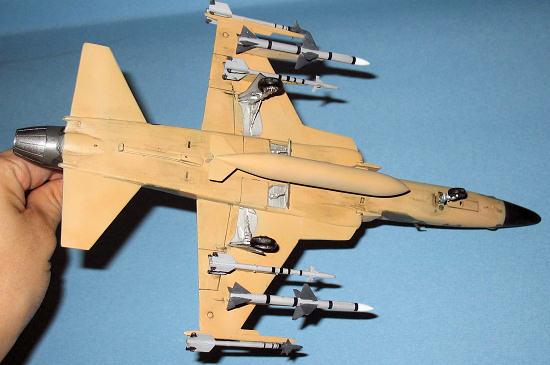 I’m rather curious as to why
other decal makers don’t use the wet transfer process, in particular for NMF
planes as the fiddliness of the decals is outweighed by the fact that these
decals don’t have carrier film and are ideal for NMF. Knowing how much work and
time is required for NMF (especially the repeated sanding); a few extra days
decaling should not be an issue.
I’m rather curious as to why
other decal makers don’t use the wet transfer process, in particular for NMF
planes as the fiddliness of the decals is outweighed by the fact that these
decals don’t have carrier film and are ideal for NMF. Knowing how much work and
time is required for NMF (especially the repeated sanding); a few extra days
decaling should not be an issue.
At this point, I had to use a bit of artistic license here as I wanted to build Ed “Devil” Lawrence’s plane and I had no idea of the ID number of his plane. Mr Tillman explained to me that all the planes would be numbered in the color of the squadron designation so I considered myself lucky that Ed commanded Black Squadron. I cut two zeroes and fours from a spare F-86 Sheet and called it Black 04 (the font might not be correct either considering that this plane did not exist except in the mind of the author so I didn’t really care.) Ed was the type who put some personal touches on his plane so I cut out three North Vietnamese Flags from an unused F-4 sheet and slapped on the port side of the F-20 (to represent his three “kills” from Vietnam.) I did not put any Israeli kill markings on as I didn’t have any (and to be honest I doubt they even exist.)
Once the decals were dry, I gently rubbed down the plane with a wet J-cloth to remove any residue and prepped it for the final flat coat of Gunze Flat.
| FINAL CONSTRUCTION |
I spent a bit of time pondering what kind of bear I should load this particular bird for—air to ground or air to air. I was leaning heavily towards Air To Ground, but two things shifted my leaning towards Air to Air:
1) I realized that in the novel, the F-20s were heavily involved in air to air combat.
2) Air To Ground ordinance is more of a pain than air to air to assemble sand and fill.
I replaced the poorly done Sparrows and Sidewinders with those salvaged from my ruined Academy Tomcat Kit (which was my first model in 20 years.) Unfortunately, I did not have enough 9Ls so I had to sub them with better looking 9Js from 1/48 Hasegawa Weapons Set C. I had to sand the Sparrows and the 9Ls because I had (over) painted them with Insignia White and then paint all the missiles Light Ghost Grey. The 9Ls noses were painted RLM66 and the IR sensors were painted lightly with silver. The Sparrows were a little more difficult as the fins were painted RLM66 and the nose was painted flat white. I added the decals from both the Academy and Hasegawa decal sheets to the missiles.
I painted the pylons, various antenna, fuel tank, outside of the gear doors and airbrake doors tan. The insides of the doors, the wheel wells, airbrake actuators, wheels and landing gear were painted with Poly S Railroad ASTF Silver. Wheels were painted with Gunze Tire Black and dry brushed with Poly S Dust.
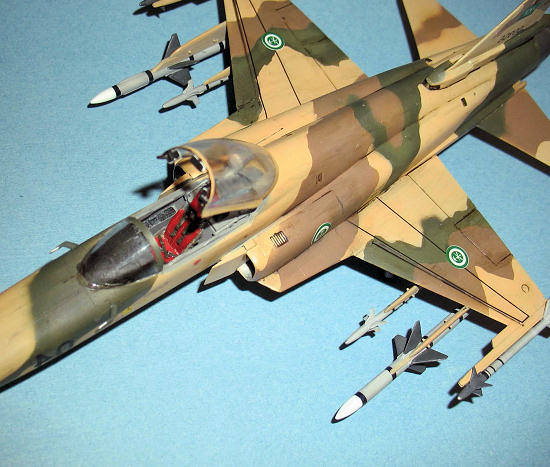 Steve Eggers mentioned in his
review that the kit Sparrow pylons were inaccurate because there was a missing
rail where the Sparrow actually hung from. I cut some lengths of 3/16” plastic
strip and glued them to the pylons to act as the railing (sans any real
detail.) It gives the Sparrow pylons the “correct” look based on the limited
information.
Steve Eggers mentioned in his
review that the kit Sparrow pylons were inaccurate because there was a missing
rail where the Sparrow actually hung from. I cut some lengths of 3/16” plastic
strip and glued them to the pylons to act as the railing (sans any real
detail.) It gives the Sparrow pylons the “correct” look based on the limited
information.
The one part I did not like about the kit was the rear landing gear which was extremely fiddly. I had to glue the landing gear and gear doors (both really “secure” butt joins) with CA glue and it still wouldn’t line up properly. It took several tries to get the F-20 to stand up straight instead of looking rather knock kneed.
The various other bits went on without too much hassle. The location of the side mounted pitot tubes were vague so I just eyeballed it and put them where it looked okay to me.
The gun barrels were replaced with Minimeca Steel tubing for a more “realistic” look. They were painted gunmetal and glued in place with CA glue.
The missiles and their pylons were glued to each other and the plane with CA glue.
The canopy was scratched up from being in the box for 20 years. I ended up carefully sanding both the inside and the outside of the canopy and then dipped it future to make it clear. Unfortunately, it didn’t work very well as it was still distorted in some places. The canopy was masked and sprayed with the interior and exterior colors and left to dry. Apparently, the canopy was dark like the F-16s, but I didn’t want to push my luck and left it (mostly) clear. I then added the canopy rear view mirrors using 10 thou plastic card, thin plastic rod and some tinfoil (not exactly to scale, but it was close enough for me.)
I completed the cockpit by gluing the KMC resin ejection seat for the AV-8B Harrier (the F-20 had the same seat) with photo etched seat belts into tub.
The last touch was super gluing a MV lens onto the forward landing gear to represent the landing light.
| CONCLUSIONS |
I was impressed with the overall quality of the Monogram F-20 Tigershark kit which has held up over time (about 20 years in the box.) There was little warping aside from the portside strake/intake piece and the plastic was not brittle as one might expect. Aside from the gaps and issues with the intake/strake pieces—which are not difficult to deal with—this model is not a sanding stick killer not like some of Mongram’s other 80s era kits.
I found this to be a fun build and recommend the kit if you can find one somewhere. It makes a nice what-if kit. Also, the FCM wet transfer decals were a pleasant but fiddly surprise. I would consider buying more if they had the markings I was looking for.
Special thanks to Barrett Tillman for pointing me in the right direction on the paint scheme and allowing me to use quotes from his novel, “Warriors.”
August 2006
If you would like your product reviewed fairly and quickly, please contact me or see other details in the Note to Contributors.